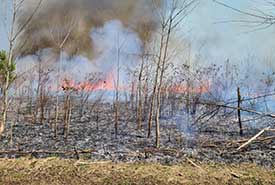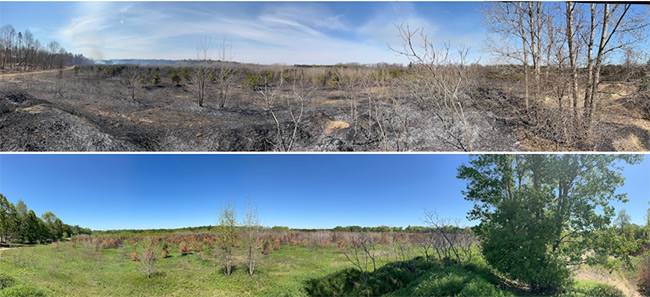A blazing start: Restoring habitat with a prescribed burn

Prescribed burn at Upper Big Creek Block of Norfolk County, ON (Photo by NCC)
How is burning a form of restoration and how does it work? Prescribed burns can be used for many different purposes: they can remove invasive species in an ecosystem, remove undergrowth on the forest floor, create new habitat for wildlife, provide more nutrients to the ecosystem and so much more. There may even be multiple benefits at the same time. After a prescribed burn, more nutrients are available to native plants and non-native, invasive species may have their populations knocked back, as they aren’t adapted for fire. This gives native species a chance to take hold and flourish.
A prescribed burn is carefully planned, set, controlled and managed by restoration professionals. After planning, the site needs to be prepared, with the burn area being broken up into blocks. These blocks are separated by burn breaks, which must be wide enough for the fire to not jump from one section to another. The burn breaks also provide access for trained personnel to safely manage the fire.
It is important that conditions are perfect before a prescribed burn can be ignited. Prescribed burns are typically done in the early spring and late fall, within wind speeds ranging from 6 to 25 kilometres per hour and in an ideal wind direction for the site. When all the conditions are right, the fire is set!
My internship as a conservation technician with the Nature Conservancy of Canada (NCC) began with a blazing start — literally! One of the first restoration projects I was lucky to be a part of was a prescribed burn for an NCC property in the Upper Big Creek Block of Norfolk County, Ontario.
This early spring day was not like any other day; the anticipation was palpable amongst the field team. We were in constant communication in the days leading up to the burn because everything had to be just right. Was the ground dry enough? Were the wind direction and speed right? All of these factors could change at any moment, meaning the difference between a successful prescribed burn, or needing to cancel the event.
NCC staff and volunteers met on-site first thing in the morning, we discussed what everyone’s role was, and we made sure we would all be able to communicate with each other throughout the day. My role was perimeter supervision, ensuring that no people crossed into potential burn areas. The section I was stationed at was at the opposite side of a very large field (40 hectares). The fire was lit by the Burn Boss, a contractor qualified to plan and conduct prescribed burns and everyone was very excited! I knew I would need to wait a while before I saw any fire because there were going to be multiple burn breaks along the way.
These are gaps in the vegetation we mow pre-emptively, before the burn to make it easier to control the fire once it is lit. By having multiple “breaks” the fire is prevented from moving too fast across the field. After a little while I could see small clouds of smoke off in the distance. The conditions were so favourable that I didn’t have to wait more than a couple of hours before my part of the field was lit! I couldn’t believe how loud the crackling of the moisture-laden horsetail was. The fire seemed to spread across the field quickly, leaving behind only black-scorched earth. Many of the trees didn’t seem impacted by it at all, as they are “fire-adapted”, except for the invasive pine trees which are vulnerable to fire at small sizes. All we had to do was wait for the fire to completely burn itself out.

Top: Burn completed. Bottom: One month after prescribed burn. (Photo by Liv Monck Whipp/NCC staff)
Post-prescribed burn, the landscape didn’t look like scorched earth for long. In just a few weeks, as Spring arrived in full, there was a fresh carpet of green, and native trees had begun to leaf out as usual. The invasive pine though, were impacted by the fire, exactly as planned. It was absolutely amazing to see the difference!
I am grateful to have been part of this unique form of restoration. This site in particular was very cool because many restoration objectives were accomplished all with one burn! The burn helped preserve a tall grass prairie by controlling the invasive pines and reducing other shrubs. I must admit, as an avid camper and someone who loves a good campfire, watching a field burn with such control was absolutely amazing! I would like to give a special thank you to the 407 ETR for supporting NCC’s intern program, allowing me to participate in unique restoration practices like a prescribed burn and learn countless new things every day.

